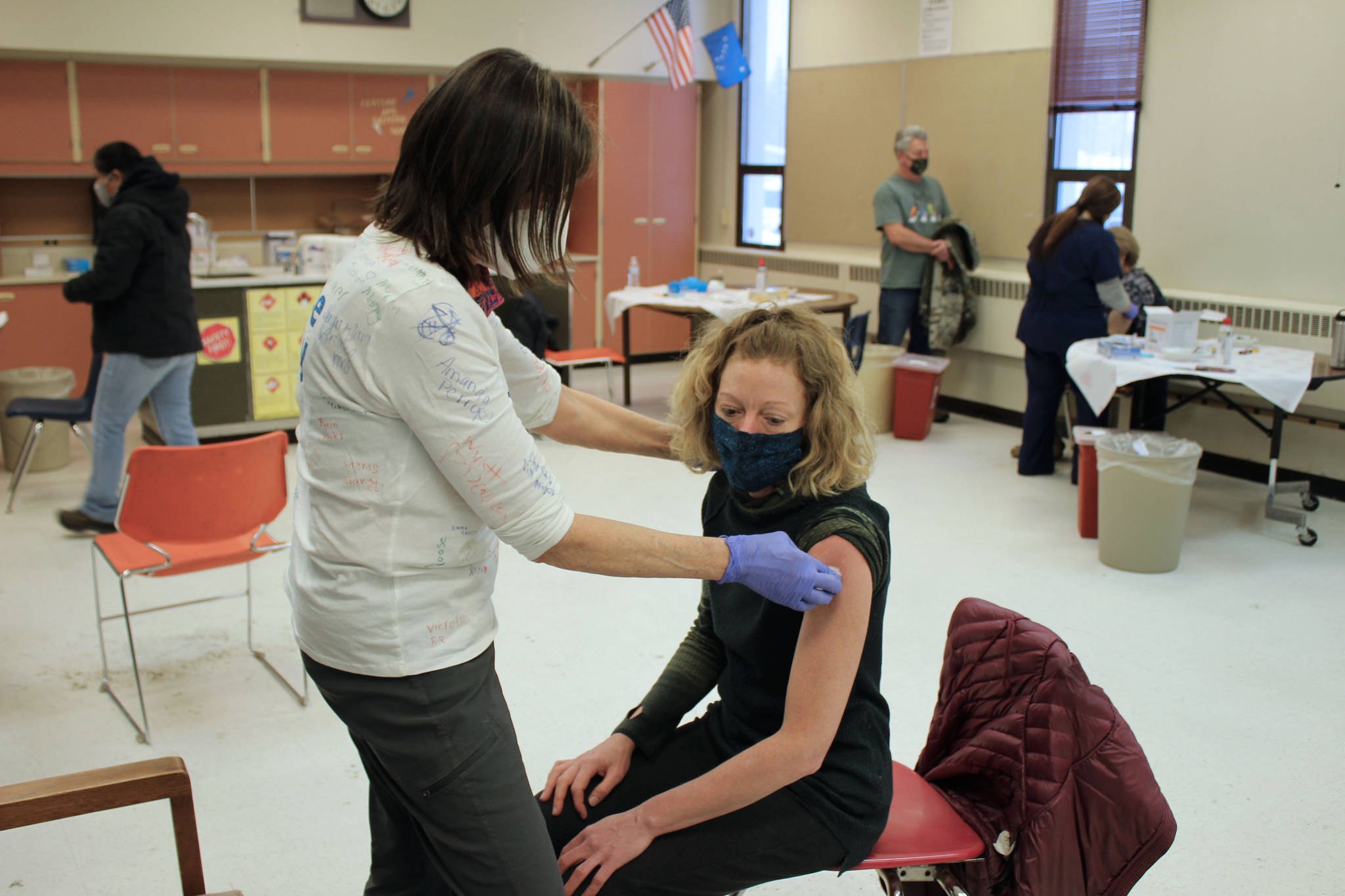Spirits were high at Soldotna Prep School on Friday, where about 250 people, most of them employees with the Kenai Peninsula Borough School District, received a first dose of the COVID-19 vaccine. The clinic, which was targeted toward KPBSD staff, was one of three for those staff held across the peninsula on Friday.
Pre-K through 12th grade education staff became eligible to receive the COVID vaccine earlier this month, along with Alaskans 50 and older who have certain high-risk medical conditions and people living or working in congregate settings.
For the three clinics, the district received 410 pairs of vaccine from the state’s allocation, including 250 pairs for the central peninsula clinic, 120 pairs for the southern peninsula clinic and 40 pairs for the eastern peninsula clinic.
In determining how many doses should be used for each clinic, KPBSD Nursing Supervisor Iris Wertz said a survey circulated among district staff last year. Wertz said that in organizing Friday’s clinic, she worked with state and local health officials to organize clinics that would be more accessible to district staff.
“I was concerned because it seemed like … the first clinics that went up all went up during the day when our staff was working,” Wertz said. “And I thought ‘oh my goodness, if that’s the way it’s always going to be, then when our tier comes open my staff are always going to be last because they’re all working during the day’.”
Wertz said that they are being especially careful to make sure no doses go to waste. Some of the vials, which purportedly have five doses, sometimes actually contain six or seven. In those instances, Wertz said they are able to call eligible people from a waitlist to come and be vaccinated.
Kenai Peninsula Borough Office of Emergency Management (OEM) Operations Manager Bud Sexton said the clinic shows how many different groups across the peninsula are working together to get people vaccinated. At Friday’s clinic at Soldotna Prep alone, KPBSD, OEM, Soldotna Professional Pharmacy, the City of Soldotna and the borough’s Community Emergency Response Team were all represented.
“[There’s] a lot of people coming together for the benefit of the community, which is great,” Sexton said.
Having held several large clinics over the past month, Sexton said they’ve been able to work out a lot of the kinks and are running a pretty smooth operation. One of their biggest challenges is when people do not show up for appointments.
“Sometimes we just have somebody that got an earlier appointment … and they don’t show up, so now we have to backfill that spot at the end of the day, because again, we don’t want any [doses] to go to waste,” Sexton said. “So sometimes we’ve been here maybe an hour and a half or so after the clinic officially ends, just because we’re calling people and getting more people to come and getting them vaccinated.”
With the way appointments are staggered and the number of vaccinators at the clinic, Wertz said, they should be able to vaccinate nine people every six minutes. Upon arriving at the clinic on Friday, people checked in near the front door. From there, a nurse took them to a vaccination station and asked them a few questions. Then, they administered the vaccine. Finally, the person getting vaccinated headed to an observation room where they waited anywhere from 15 to 30 minutes while checking out.
Both Pfizer and Moderna’s COVID-19 vaccines have efficacy rates of more than 90% and require two doses to be fully effective. Doses of Pfizer’s vaccine must be administered 21 days apart, while Moderna’s doses are 28 days apart. Because staff at the clinic received a first dose of the Pfizer vaccine, the second dose clinic is scheduled for March 19.
Alaska has consistently led the nation in vaccine rollout, with more than 20% of all Alaskans having already received at least one dose of the COVID vaccine. That’s compared to 13.9% nationwide and 19.8% in New Mexico, the state with the second-highest rate, according to NPR’s COVID vaccine tracker.
State health officials said last week that Alaska will receive more than 100,000 pairs of vaccine for the month of March, which is comparable to the 174,400 pairs of vaccine the state received for the months of December, January and February combined.
The clinic comes roughly a month after students in all grade levels at all district schools were allowed to resume on-site learning in response to low rates of community COVID-19 transmission.
Students at most district schools were attending school 100% remotely for a lot of the first and second academic quarters. The district revised their COVID operations in December, which provided for more flexibility when students came back to school in 2021.
Tamra Wlaters, who is a nurse at Sterling Elementary school and was administering vaccines at Friday’s clinic, said that it’s been great having kids back in school and that they’ve had little problems with students complying with COVID mitigation protocols, such as wearing masks.
“Even the little preschoolers are good,” Walters said. “Very rarely do I have to tell them to pull their masks up.”
The central peninsula’s clinic, which was held at Soldotna Prep School, was offered by KPBSD school nurses and staff with oversight from Soldotna Professional Pharmacy and the Kenai Peninsula Borough Office of Emergency Management. In Homer, a clinic held at Christian Community Church was staffed by district school nurses and staff and Community Emergency Response Team staff, with oversight from South Peninsula Hospital. The eastern peninsula’s clinic was held at and hosted by the Seward Community Health Center.
Reach reporter Ashlyn O’Hara at ashlyn.ohara@peninsulaclarion.com.

